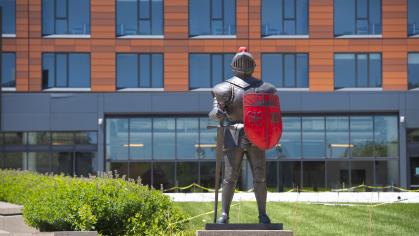Occupational Health Department Proves Mettle in Multifaceted COVID-19 Response Plan
Just one month after Rutgers’ RUCDR Infinite Biologics received Emergency Use Authorization from the Food and Drug Administration (FDA) on April 13, 2020, for its saliva-based COVID-19 test, developed in partnership with Spectrum Solutions and Accurate Diagnostic Labs (ADL), Rutgers University–New Brunswick’s Occupational Health Department would help the university implement a strategic testing program that would govern its efforts to mitigate outbreaks among its more than 24,000 part-time and full-time faculty and staff and its population of 70,000-plus students.
In looking back at the early foundations of the program, its evolution over the past year, and its enduring impact, Milind N. Shah, M.D., MPH, Director of Rutgers–New Brunswick’s Occupational Health Department, considers the testing infrastructure to be a timely success illustrative of “the work of student health and occupational medicine.”
“Our testing data shows that Rutgers had always been much lower than the state in terms of percent positivity. We have really robust data that shows that we were able to mitigate the effects of each COVID-19 surge that we had on campus, in the dorms, and in athletics,” Shah said. “That has really shown our worth to the university. We're proud of what we did, we're still doing it, and we'll keep doing it as long as we can.”
The university’s strategic testing program, developed under the leadership of Brain Strom, M.D., MPH, Chancellor of Rutgers Biomedical and Health Sciences (RBHS); Vicente Gracias, M.D., Senior Vice Chancellor for Clinical Affairs; Melodee Lasky, M.D., Associate Vice President for Student Health; and Shah, first launched in May of 2020 to offer a drive-through COVID-19 testing method to students, faculty, and staff required to satisfy Rutgers’ regular testing requirement. Institutional Planning and Operations staff Alejandro Ruiz and Nick Taylor were also instrumental in creating the testing database, lab interface, and logistics to expand testing, Shah said.
Over time, the testing framework has matured in step with the expansion of testing methods. Though Rutgers initially rolled out the program in the drive-through format, the university has since created “other means of testing,” according to Shah, such as “grab and go” COVID-19 test centers and vending machines (the brainchild of Ruiz) that dispense tests for at-home use.
A large part of the program’s success can be attributed to the saliva test, developed by the late Andrew Brooks, who formerly served as RUCDR’s chief operating officer and director of technology development. The technology behind the test, which was notably the first of its kind to receive FDA approval, “really enabled the testing program to take off and to exponentially increase its effectiveness over time because the test is meant to be used as an at-home method,” Shah said. The result? No more nasal swabs and the advent of at-home testing for Rutgers’ population.
“Our people can now do these tests their cars, in their homes, or in their private offices and then return the tests at any number of campus drop boxes. It’s private, secure, and the test is very sensitive and specific. The saliva test technology was critical to our testing program here at Rutgers, and more broadly, to testing efforts throughout the country,” Shah said.
As Lasky, Shah, fellow Occupational Health and Student Health colleagues, and other university personnel worked to not only put the testing program in place but also refine it throughout the COVID-19 pandemic, in addition to continuing to fulfill their standard, non-COVID-related responsibilities, they also were conducting contact tracing.
“There were not many resources for contract tracing at the local- and county-level to help us. Historically, that's always been a weakness, and we found that over the years, the public health infrastructure in the United States was not great,” Shah explained. “The local health departments were overwhelmed. It was a pretty scary time, but then we started to get more resources allocated to the program of testing and tracing, so we were able to start hiring some help for testing and tracing.”
Rutgers moved quickly and efficiently to onboard contact tracers through the School of Public Health in response to the mountain of test result follow-ups that also fell under Student Health and Occupational Health’s management. In sum, the efforts were not for naught: “Once the spring semester came around, we had more testing and tracing capabilities in place, so we were better able to manage the volume of testing and tracing with more students and employees gradually returning over the spring semester,” Shah attested.
The contact tracing and testing programs can be considered stepping stones to Rutgers’ March 25, 2021 mandate that all students must be fully vaccinated prior arriving on campus for the fall 2021 semester. The announcement made national and international headlines, prompting Rutgers to become the first major university in the United States to require COVID-19 vaccination. As several other institutions echoed Rutgers in the weeks that followed, publicizing their own intent to make vaccination mandatory, Lasky, Shah, and colleagues were on the brink of finalizing Rutgers’ vaccine program — to the extent that a program can be finalized amid the ever-changing landscape of COVID-19.
The university received all FDA-approved vaccines the week of May 3 and immediately began administering them across its vaccination sites in Camden, Newark, and Piscataway on May 5. Currently, Rutgers has the capacity to vaccinate up to 1,350 people each day across each of its three vaccine clinics.
The establishment of the clinics acts as a light at the end of a long tunnel, said Shah. “We’re constantly pivoting. We went from testing to tracing and now, vaccinations. Dr. Lasky and I were on several calls with the state trying to get the vaccine for Rutgers, and we talked at length about who were going to get it. We've all been trying to manage our day jobs while working on the COVID-19 response, and it's been very difficult, but we've had a great team working on it in Occupational and Student Health. Hopefully, this is the final leg of the journey with COVID-19,” he remarked.
Over the past year-plus, many facets of the COVID-19 pandemic have been unclear and riddled with uncertainty, but when asked what about the Occupational Health Department’s response to the respiratory illness illustrated about the department’s value, Shah was adamant that there is no ambiguity about Occupational Health’s continued relevancy as a cornerstone of Rutgers’ health-focused initiatives. Throughout the country and the world, “employers all have the same challenges with COVID-19 such as keeping employees at work or removing them if they're infected, contact tracing their colleagues, administering testing,” Shah said. “I think we really showed our mettle and were able to rise to the challenge of keeping employees safe and mitigating risk for Rutgers.”


